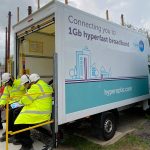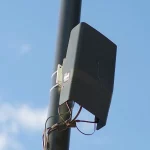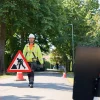GBP5bn UK Gigabit Broadband Rollout Starts in Central Scotland

In a surprise twist the UK Government has technically started the rollout phase of their £5bn Gigabit Broadband Programme early by reaching a unique agreement with the Scottish Government’s existing £579m Reaching 100% (R100) project, which will see them replace FTTC with FTTP in rural parts of Central Scotland.
Under the deal more than 5,368 premises (homes and businesses) in Ayrshire, Edinburgh, Falkirk, Fife, Stirlingshire, Greater Glasgow and Lothian will get access to gigabit speeds thanks to the first £4.5m to be awarded under the UK government’s nationwide gigabit programme. But explaining why they’re able to do this, before the £5bn programme has even properly begun, requires a brief history lesson.
The original R100 contract for LOT 2 (Central Scotland), which alone is worth £83m, was awarded to Openreach (BT) back in October 2019 (here) and they began the rollout phase last year. In LOT 2, of the originally eligible 55,000 premises, the contract – alongside greater than anticipated commercial build – was set to reach at least 47,000 premises and the “vast majority” would be done using gigabit-capable Fibre-to-the-Premises (FTTP).
Advertisement
Meanwhile the much more recent UK Gigabit Broadband Programme, which has initially only released £1.2bn of its total funding pot for the next 4 years of work, aims to help extend “gigabit-capable” network coverage (mostly FTTP) to a minimum of 85% by the end of 2025 – before getting “as close to 100% as possible” (this scheme targets its help toward the final 20% of predominantly rural premises).
However, the UK Government’s new gigabit programme is still in its pre-launch phase and remains far away from being able to award its first contracts. But in this case the Building Digital UK (DCMS) team appear to have done some outside of the box thinking and come up with an additional way of maximising gigabit coverage, before any new contracts have been awarded.
In short, they supplied additional funding to help tackle those areas in R100 LOT 2 that might have otherwise only received a much slower Fibre-to-the-Cabinet (FTTC / VDSL2) service, which is because R100’s official goal was to ensure that virtually all of Scotland can access a “superfast broadband” (30Mbps+) network (i.e. it was established long before the modern ‘gigabit’ focus took hold). But now those areas will get 1000Mbps capable FTTP instead, just like the rest of LOT 2.
“On the basis that the UK Gigabit Programme would have to revisit these 5,368 premises at some point in the future to convert them to FTTP, the Scottish and UK Governments have agreed a technology ‘flip’ from FTTC to FTTP. This offers the chance to reduce build costs, enabling delivery of the connections earlier and at greater value for money,” said the announcement.
Advertisement
Matt Warman, UK Minister for Digital Infrastructure, said:
“The first pound to be spent from our £5 billion pot for gigabit broadband will be in Scotland.
That’s because it is our mission to deliver lightning-fast next-generation internet connections to all parts of the UK as we build back better from the pandemic.
And this is just the start. Other areas of Scotland and the rest of the UK will benefit from our record investment in this national broadband upgrade and we’ll announce more regions shortly.”
Paul Wheelhouse, Scotland’s Connectivity Minister, said:
“The past year has demonstrated beyond doubt just how vital digital connectivity is across all areas of our lives – from health, wellbeing and education to social and economic recovery. That’s why the Scottish Government is investing £579 million in funding towards the £600 million cost of our Reaching 100% programme, building the infrastructure which, together with commercially-driven work, will ensure access to superfast broadband speeds to 100% of homes and businesses across Scotland.
The vast majority of connections being delivered to more than 120,000 premises through our investment in the three R100 area contracts – 100% in South, 86% in North and, now, 95% in Central – will be through fibre directly to the premises, delivering gigabit capability, providing connection speeds 30 times faster than our superfast commitment, and resilient, future-proofed connectivity for decades to come.”
The agreement raises the prospect of a similar approach being adopted for other contracts across the United Kingdom (the announcement suggests that more areas will follow), although in reality the impact of this may be fairly limited because very few contracts signed during the past 2-3 years has involved much FTTC (i.e. R100 was largely negotiated prior to this change of strategy, which now sees FTTP take precedence).
On the political front this also means that the UK Government can claim to have started the rollout of their new gigabit programme, but in reality it probably won’t be awarding any of its own contracts until much later this year and thus the first deployments under those might not begin until early 2022 or thereabouts. But we do like the more pro-active and logical approach being demonstrated above.
We predict that R100’s LOT 1 (Northern Scotland) contract may be one of the next to benefit. Most of that is also FTTP, but as can be seen from the comment made by Paul Wheelhouse above, there does look to be some FTTC that is ripe for conversion. As LOT 1 was only recently signed, following delays from a protracted legal dispute with one of the previous bidders (Gigaclear), then it might be later this spring before we hear the outcome.
Mark is a professional technology writer, IT consultant and computer engineer from Dorset (England), he also founded ISPreview in 1999 and enjoys analysing the latest telecoms and broadband developments. Find me on X (Twitter), Mastodon, Facebook, BlueSky, Threads.net and Linkedin.
« Cityfibre’s 1Gbps FTTP Broadband Goes Live in Portsmouth UK
ISP Plusnet Scraps Pre-Paid UK Line Rental Saver Discount »






















































This has to be sensible as public money should not be spent subsidising technology that is known not to meet even the medium term need (less than 9 years).
In the proposed Out/In Procurement criteria it included superfast in exceptional circumstances. Hopefully this has also been revised.
I’m sure the SNP are not too bothered what they spend England’s money on.
Meanwhile, Sir Ian Blackford just asked Westminster for £98bn. Maybe they need it to pay for their legal fund in the Salmond case.
Didn’t take long for the first “SNP is baaaaaad” comment!
They are though haha. Wee Jimmy is as bad as BoJo is
Wonder if this means the town of Shotts will finally get some type of fast internet as Virgin announced a year ago they had interest in our town but haven’t heard back from them since currently stuck on FTTC which is across the road but extremely slow at times
With this funding it would only be if you are unable to get 30mbps.
Political point scoring aside, As a UK Funded programme I’m very pleased though surprised that this has been achieved.
It usually seems impossible to cross fund projects despite the logical benefits of doing so resulting in wasted money and time.
There should logically be a ban across any public sector procurements for even considering using FTTC products. This is to prevent use of FTTC even as a temporary measure until “gigabit-capable” ( – mainly but always full-fibre). Otherwise public money will be wasted.
To support this DCMS should be called upon to step-in and offer the additional funding to public sector organisations who cannot the additional cash short term to buy FTTP compared to FTTC.
Logically?
FTTP costs more per building passed than FTTC. If you have an amount of money you can do lots of FTTC or less FTTP.
If you have a village with little to no connectivity is it better to give all of the residents a good standard of connectivity, or is it better to give a handful of them amazing connectivity and the rest nothing?
I disagree that the money would be wasted in the former scenario and I doubt the people in the latter scenario with no connectivity would applaud your far-sighted vision, because it means they get nothing.
FTTC will be with us for at least a decade. Buying an asset with a decade or more’s life is not wasted money.
@125US FTTC costs less per building passed because it re-uses existing copper. But it does cost something – the installation of the cabinet and associated active equipment-which has an ongoing power and maintenance cost, not something that a GPON network has. And the lifetime of that equipment will be shorter than you think. BT have already realised this for their commercial rollout – g.fast is dead and all new infrastructure is FTTP. So why advocate progressing down this non-upgradeable dead end for a publicly-subsidised rollout?
I’m stuck on sub-2Mbps ADSL, with a brand new AIO FTTC cabinet a few yards from my door to which Openreach refuse to connect me. Presumably because they can put it off indefinitely until the FTTP rollout happens, the only schedule for which is “after 2021”.
Brilliant, thanks for that.
If I was being cynical, it’s almost like BT tried to maximise their revenue from their copper cables for as they could
When Elon stepped up his satellite Internet, Virgin ramped up their 500+ Meg service and the smaller fibre operators stepped up their game, BT seem to have been forced into the game with EE doing great work in the background.
Alec L what are you on about – disinformation as ever
“in rural parts of Central Scotland.”
no such thing.
Yes there is. Plenty of farms with only ADSL if you’re lucky.
Central Scotland (Lot 2) includes Fife. Where I am is plenty rural and gets between 1 and 2 Mbps ADSL when it’s working at all. Even a zoom audio conf won’t work reliably.
Common sense has prevailed.. a rare sight.
scarily the gigaclear scemantics in scotland about contesting a contract they were very unliukley to win based on the CDS issues and has actually helped this scenario as the gap between the original preferred bidder status and contract scemantics have enabled the tehnology discussion to take place and therefore deliver more with FTTP
What do they base the 30mbps on? BT Wholesale Checker reports 35mbps down MAX and 20mbps LOW, I am definitely on the borderline
No mention of Openreach or BT in this – I take it they must have contributed more money to be able to get the finding added to the contract . Noting aid intensity rates and it being central Scotland -Worth hazarding a guess it was millions too ? Worth asking pls for comment? What do they contribute for tax payers money